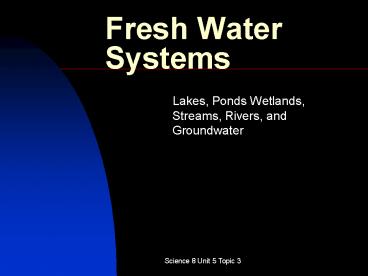Fresh Water Systems - PowerPoint PPT Presentation
1 / 13
Title:
Fresh Water Systems
Description:
Fresh Water Systems Lakes, Ponds Wetlands, Streams, Rivers, and Groundwater Freshwater systems Exist above ground in lakes, ponds, streams, and wetlands Lake Ponds ... – PowerPoint PPT presentation
Number of Views:54
Avg rating:3.0/5.0
Title: Fresh Water Systems
1
Fresh Water Systems
- Lakes, Ponds Wetlands, Streams, Rivers, and
Groundwater
2
Freshwater systems
- Exist above ground in lakes, ponds, streams, and
wetlands
- Exist as ground water
- Exist in the air as water vapour.
- Exist in three different states
- Solid
- Liquid
- Gas
3
Lake Ponds Wetlands
- Lakes and ponds are holes in the ground filled
with water
- Lake is deeper . . . Sunlight does not go to the
bottom (depending on clarity the amount of
dissolved solids suspended in the water)
- Wetlands are low areas that are almost always
saturated with water. Wetlands provide a habitat
for a surprising number of organisms
4
Streams and rivers
- Flowing waterways . . . Fast flowing rivers and
streams are usually rich in oxygen
- Stream or river profile is a description of its
characteristics - Flow rate
- Steepness of bed
- Erosion rate of its banks
5
Streams and rivers cont
- Source of streams and rivers may be high in the
mountains (melting snow and ice from glaciers)
- Small streams gather into one channel forming a
river.
- In the early stages flow is swift and the river
is fairly straight.
- As the river reaches lower elevations it slows
and meanders (curves.) It begins to drop the
sediment it was carrying to form deltas. Really
good example Fraser River flowing to Vancouver.
6
Streams and rivers cont
- The Fraser River begins in the mountains ends in
the Pacific Ocean
7
Watershed
- Also called a drainage Basin
- It is all the area of land that drains into one
main body of water.
- It can contain streams rivers lakes.
- The location of the highest land on the continent
determines the direction of the flow. This is
called the continental divide. In N. America,
its the Rocky Mountains.
- The river begins at the Headwaters and ends at
the Outflow usually at the mouth of the river.
8
7 Major Watersheds in Alberta
- Peace/Slave Athabasca Hay River flow into
Arctic Ocean - Beaver North and South Saskatchewan Rivers flow
into Hudsons Bay - Milk River flows into the Gulf of Mexico
9
Run-off and Erosion
- Moving water is a powerful force.
- Washes soil away wears away or dissolves rock
(universal solvent remember?) - The sediment load of the river/stream is
determined by the flow, steepness, vegetation,
what the banks and bottom are made of (rock or
soil)
10
Why is monitoring sediment important?
- When we know how much and what makes up the
sediment in rivers and streams we can determine
the source of pollutants and measure their impact
on plants, animals and our drinking water supply.
11
Project for this topic
- A webquest
- Individual work
- Small groups (groups of 3 students)
- Presentations
12
What is this Webquest
- The quest begins with role-play. Acting as
members of a Watershed Advisory Task Force,
students will work on the development of a new
water policy, first as individuals and then as
part of a team. The quest culminates with each
team presenting their recommendations to Alberta
Environment (the class). - We will quickly discover we all live downstream.
13
What are the timelines?
- Class 1 today, review topic, pick groups.
- Classes 2 3 research stakeholder point of view.
- Class 4 put together team presentation
- Class 5 make presentations (may need 1 extra day)

